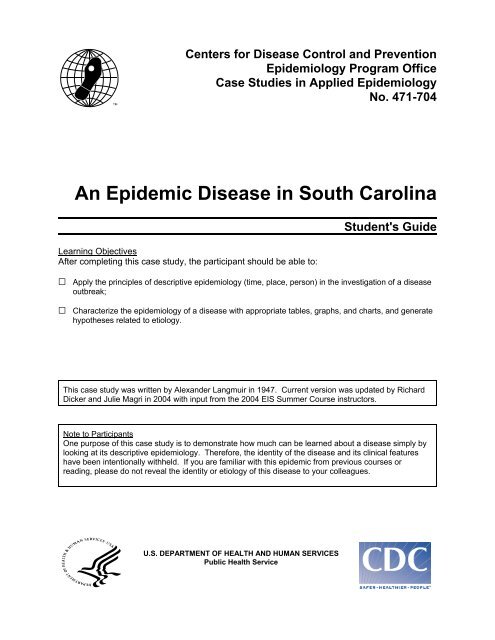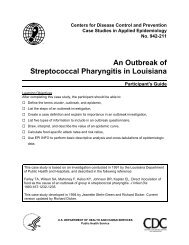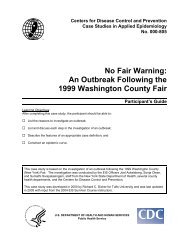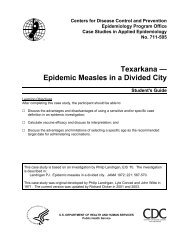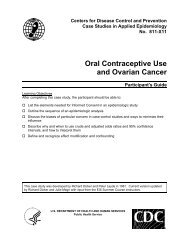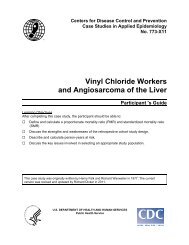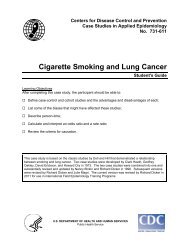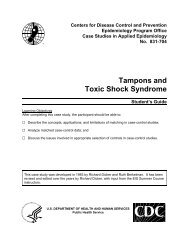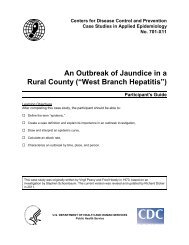case studies X\XUnknown Disease in SC\Xunkdis_sc ... - Library
case studies X\XUnknown Disease in SC\Xunkdis_sc ... - Library
case studies X\XUnknown Disease in SC\Xunkdis_sc ... - Library
Create successful ePaper yourself
Turn your PDF publications into a flip-book with our unique Google optimized e-Paper software.
CDC / EIS Summer Course 2004: Epidemic <strong>Disease</strong> <strong>in</strong> S.C. - Student's Guide Page 2PART IOver a period of years, physicians <strong>in</strong> the ruralsoutheastern United States reported theoccurrence of a disease that had not beenrecognized previously. S<strong>in</strong>ce report<strong>in</strong>g wasrequired <strong>in</strong> only one state, and s<strong>in</strong>ce medicalservices were limited, record<strong>in</strong>g of the <strong>in</strong>cidenceof this disease was irregular.Although the disease <strong>in</strong> question was easilydiagnosed on cl<strong>in</strong>ical grounds, the etiology wasunknown at the time. Pathogenesis, mode ofspread, immunity, and the role of social andenvironmental factors were matters ofcontroversy. Many theories concern<strong>in</strong>g thenature of the disease were proposed.In an effort to determ<strong>in</strong>e the extent of thedisease, a questionnaire was mailed to allpractic<strong>in</strong>g physicians <strong>in</strong> eight states <strong>in</strong> theSoutheast regard<strong>in</strong>g the number of <strong>case</strong>s theyhad seen <strong>in</strong> the preced<strong>in</strong>g 5 years. Onlyone-fourth of the physicians responded. Theyreported an <strong>in</strong>crease from 622 to 7,017 <strong>case</strong>sover the 5-year <strong>in</strong>terval.The follow<strong>in</strong>g year, a U.S. Public Health Serviceepidemiologist was assigned to <strong>in</strong>vestigate theepidemic. After some prelim<strong>in</strong>ary observations,a field survey was conducted to determ<strong>in</strong>e theextent and the nature of the disease.Question 1:Into what general etiologic categories might one divide diseases that can occur <strong>in</strong>epidemic form?The survey was conducted <strong>in</strong> a five-countyregion <strong>in</strong> northwestern South Carol<strong>in</strong>a where thedisease was prevalent. The survey area<strong>in</strong>cluded 24 mill towns with populations from 500to 1,500. These villages varied widely <strong>in</strong> theirsanitary status. Some had public water supplies,some had sewage systems, some had both, andsome had neither. The survey focused onfamilies of a s<strong>in</strong>gle racial group.In each village, bi-weekly visits were made toeach household over a period of 1 year to lookfor <strong>case</strong>s. The name, age, sex, and maritalstatus of each member were recorded. Theoccurrence of the disease was determ<strong>in</strong>ed byhistory and exam<strong>in</strong>ation. Questionable <strong>case</strong>swere referred to one of the directors of the studywho had considerable experience <strong>in</strong> diagnos<strong>in</strong>gthe disease.Question 2:What categories of <strong>in</strong>formation would you want <strong>in</strong> order to de<strong>sc</strong>ribe the epidemic?
CDC / EIS Summer Course 2004: Epidemic <strong>Disease</strong> <strong>in</strong> S.C. - Student's Guide Page 4Table 2. Incidence of the disease by age and sex <strong>in</strong> 24 villages surveyed for one yearMalesFemalesAge group Rate per Rate per(years) Population* # Cases 1,000 Population* # Cases 1,00070 80 6 75.0 114 2 17.5Total 10,812 483 44.7 11,238 664 59.1* As enumerated between May 1 and July 15.Question 4a:From Table 2, graph the rates of disease by age and sex.Question 4b: What can you tell about this disease from Table 2 and these graphs?
CDC / EIS Summer Course 2004: Epidemic <strong>Disease</strong> <strong>in</strong> S.C. - Student's Guide Page 5Table 3. Incidence of the disease among women by marital status and by ageMarried womenS<strong>in</strong>gle womenAge group Cases per Cases per(years) Population # Cases 1,000 pop. Population # Cases 1,000 pop.16-29 1,905 89 46.7 1,487 16 10.730-49 1,684 98 58.2 141 4 28.450+ 387 4 10.3 26 0 0Total 3,976 191 48.0 1,654 20 12.1Question 5:Us<strong>in</strong>g the data <strong>in</strong> Table 3 , compare the rates of disease between married and s<strong>in</strong>glewomen.
CDC / EIS Summer Course 2004: Epidemic <strong>Disease</strong> <strong>in</strong> S.C. - Student's Guide Page 6Table 4. Incidence of The <strong>Disease</strong> by Occupation, Age, and SexMill Age group AttackSex worker? (years) Ill Well Total rate (%)Female Yes 55 0 5 5 0Subtotal 8 631 639Female No 55 1 92 93 1.1Subtotal 66 1384 1450Male Yes 55 1 51 52 1.9Subtotal 8 1178 1186Male No 55 4 26 30 13.3Subtotal 33 852 885Question 6:Us<strong>in</strong>g Table 4, calculate and compare the overall attack rates for:a. Mill workers versus non-mill workers (regardless of sex).b. Female mill versus female non-mill workers.c. Male mill versus male non-mill workers.
CDC / EIS Summer Course 2004: Epidemic <strong>Disease</strong> <strong>in</strong> S.C. - Student's Guide Page 7Table 5. Population and number of households affected by the disease over a 9-month period <strong>in</strong> 7 SouthCarol<strong>in</strong>a villagesTotal population 4,399• Population <strong>in</strong> affected households 424• Population <strong>in</strong> unaffected households 3,975Total number of <strong>case</strong>s 115• Number of first <strong>case</strong>s <strong>in</strong> affected households 77• Number of additional <strong>case</strong>s <strong>in</strong> affected households 38(subsequent <strong>case</strong>s <strong>in</strong> a household after the first <strong>case</strong>)Total number of households 798Question 7a:Based on the data <strong>in</strong> Table 5, what is the overall attack rate for the disease <strong>in</strong> thecommunity?Question 7b:What proportion of households are affected with the disease <strong>in</strong> the community?Question 7c: What is the risk that an unaffected <strong>in</strong>dividual <strong>in</strong> a household that already has a <strong>case</strong> willalso contract the disease?Question 7d: What are the average household sizes for affected and for unaffected households?Question 7e: Interpret the results of your analysis of the data <strong>in</strong> Table 5.
CDC / EIS Summer Course 2004: Epidemic <strong>Disease</strong> <strong>in</strong> S.C. - Student's Guide Page 8Table 6. Incidence of the disease by economic status <strong>in</strong> 24 villages* surveyed for 1 yearFamily Ratesocioeconomic status Cases Population per 1,000Stratum 1 (lowest) 99 796 124.4Stratum 2 240 2,888 83.1Stratum 3 260 4,868 53.4Stratum 4 177 5,035 35.2Stratum 5 132 5,549 23.8Stratum 6 23 1,832 12.6Stratum 7 (highest) 2 769 2.6Total 933 21,737 42.9* Restricted to <strong>case</strong>s develop<strong>in</strong>g after 30 days of residence.Question 8a:Us<strong>in</strong>g the data <strong>in</strong> Table 6, de<strong>sc</strong>ribe the relationship, if any, between socioeconomicstatus and disease.Question 8b:In general, what factors related to low socioeconomic status might <strong>in</strong>fluence theoccurrence of disease?
CDC / EIS Summer Course 2004: Epidemic <strong>Disease</strong> <strong>in</strong> S.C. - Student's Guide Page 9The <strong>in</strong>vestigators also conducted sanitarysurveys. Each village, as a unit, was rated forquality of general cleanl<strong>in</strong>ess, excreta disposal,and water supply. The figure below shows a<strong>sc</strong>atter diagram of <strong>in</strong>cidence of disease andsanitary rat<strong>in</strong>g for 24 villages. The figure alsoshows the least-squares regression l<strong>in</strong>e. (On the<strong>sc</strong>atter diagram, high sanitary rat<strong>in</strong>g means goodsanitation.)Question 9:Di<strong>sc</strong>uss the relationship between <strong>in</strong>cidence of the disease and the sanitary rat<strong>in</strong>g.
CDC / EIS Summer Course 2004: Epidemic <strong>Disease</strong> <strong>in</strong> S.C. - Student's Guide Page 10Question 10:Summarize the important epidemiologic characteristics of the disease determ<strong>in</strong>ed atthis po<strong>in</strong>t.Question 11: Develop a hypothesis about the cause of the disease that could expla<strong>in</strong> these f<strong>in</strong>d<strong>in</strong>gs.
CDC / EIS Summer Course 2004: Epidemic <strong>Disease</strong> <strong>in</strong> S.C. - Student's Guide Page 11Two different commissions studied the evidencerelated to this disease. The first commissionended its <strong>in</strong>vestigation with these conclusions:"(1) Accord<strong>in</strong>g to the weight of evidence (the)disease (is) due to <strong>in</strong>fection with a liv<strong>in</strong>gmicro-organism of unknown nature; (2) Apossible location for this <strong>in</strong>fection is the <strong>in</strong>test<strong>in</strong>altract; and (3) Deficient animal prote<strong>in</strong> <strong>in</strong> the dietmay constitute a predispos<strong>in</strong>g factor <strong>in</strong> thecontraction of the disease."Two years later, the second commissionconcluded that: "(1) The supposition that the<strong>in</strong>gestion of good or spoiled maize is theessential cause of (the disease) is not supportedby our study; and (2) (The disease) is <strong>in</strong> allprobability a specific <strong>in</strong>fectious diseasecommunicable from person to person by meansat present unknown."A year later, the commission presented thefollow<strong>in</strong>g at the annual meet<strong>in</strong>g of the AmericanMedical Association:"In the group of <strong>in</strong>cident <strong>case</strong>s most thoroughlystudied, evidence of close association with apreexist<strong>in</strong>g <strong>case</strong> was di<strong>sc</strong>losed <strong>in</strong> more than 80per cent."A house-to-house canvass of the homes of over5,000 people liv<strong>in</strong>g <strong>in</strong> six endemic foci of (thedisease) failed to di<strong>sc</strong>lose any def<strong>in</strong>ite relation ofthe disease to any element of the diet."In these six villages new <strong>case</strong>s orig<strong>in</strong>atedalmost exclusively <strong>in</strong> a house <strong>in</strong> which apreexist<strong>in</strong>g <strong>case</strong> was liv<strong>in</strong>g, or next door to sucha house, suggest<strong>in</strong>g that the disease has spreadfrom old <strong>case</strong>s as centers."Question 12: For each of the epidemiologic characteristics of time, place, and person, which etiologichypothesis (<strong>in</strong>fectious vs. dietary) is more compatible with the data?Question 13:How might you test the <strong>in</strong>fectious or dietary hypothesis about the cause of the disease?
CDC / EIS Summer Course 2004: Epidemic <strong>Disease</strong> <strong>in</strong> S.C. - Student's Guide Page 14Question 16: Analyze the data <strong>in</strong> Table 8.Question 17:Interpret these results.
CDC / EIS Summer Course 2004: Epidemic <strong>Disease</strong> <strong>in</strong> S.C. - Student's Guide Page 15PART IV - CONCLUSIONThe disease under <strong>in</strong>vestigation was pellagra.Pellagra was virtually unknown <strong>in</strong> the UnitedStates until 1907, although sporadic deaths werereported <strong>in</strong> 1889 and 1902. The first epidemic ofpellagra occurred at the Mount Vernon(Alabama) Asylum for Negroes <strong>in</strong> 1906, with 85<strong>case</strong>s and 53 deaths. Although pellagra wasthought to be most prevalent <strong>in</strong> Georgia, NorthCarol<strong>in</strong>a, South Carol<strong>in</strong>a, Florida, Alabama,Mississippi, and Louisiana, these states did notparticipate <strong>in</strong> national mortality registration.Nonetheless, the number of reported deathsfrom participat<strong>in</strong>g states rose from none <strong>in</strong> 1904to 1,015 <strong>in</strong> 1913.Dr. Joseph Goldberger was requested by theSurgeon General to <strong>in</strong>vestigate the pellagraproblem <strong>in</strong> March 1914. At that time the Italian<strong>sc</strong>hampioned the hypothesis that the disease wa<strong>sc</strong>aused by spoiled corn, while the Americanswere conv<strong>in</strong>ced it was an <strong>in</strong>fectious disease.Three observations made Goldberger suspect anutritional disease:1. Although the disease was endemic <strong>in</strong>asylums, attendants and professionals hadnever contracted a s<strong>in</strong>gle <strong>case</strong>.2. The disease was almost exclusively conf<strong>in</strong>edto the poor.3. The disease was most common <strong>in</strong> ruralareas.In June 1914, Goldberger published his firstreport on his observations at the asylum <strong>in</strong>Milledgeville, Georgia, not<strong>in</strong>g that professionalsand attendants did not get pellagra. He notedsignificant dietary differences <strong>in</strong> the habits of thepatients and non-patients, especially with regardto consumption of meat and milk.In 1915, Goldberger <strong>in</strong>stituted an enrichedfeed<strong>in</strong>g program <strong>in</strong> two Mississippi orphanagesthat had a pellagra prevalence of 47%. As aresult, no <strong>case</strong>s of pellagra occurred thefollow<strong>in</strong>g year among 103 patients. Also <strong>in</strong>1915, Goldberger visited the Rank<strong>in</strong> StatePenitentiary <strong>in</strong> Mississippi where no <strong>case</strong> ofpellagra had ever been reported. He <strong>in</strong>ducedpellagra after 5½ months among six out of 11<strong>in</strong>mates by plac<strong>in</strong>g them on a diet conta<strong>in</strong><strong>in</strong>g nomeat, milk, or fresh vegetables.In 1916, Goldberger began trials of pellagratransmission. Us<strong>in</strong>g himself, his wife, and 12other volunteers, he <strong>in</strong>jected blood frompellagrous patients <strong>in</strong>to healthy people. He alsoconsumed a mixture of feces, ur<strong>in</strong>e, vomitus,and sk<strong>in</strong> <strong>sc</strong>ales from pellagrous patients.Neither he nor the other subjects developedpellagra. Later that year, he <strong>in</strong>itiated his SouthCarol<strong>in</strong>a mill-town study, first <strong>in</strong> seven villages,later <strong>in</strong> 24 villages.From 1918 to 1926, Goldberger conducted<strong>studies</strong> to f<strong>in</strong>d pellagra-prevent<strong>in</strong>g (P-P) factor.He <strong>in</strong>itially focused on am<strong>in</strong>o acids. Tryptophanwas shown to have some effect <strong>in</strong> prevent<strong>in</strong>gpellagra. He found that dried yeast had highestP-P activity. P-P appeared to be a watersoluble,heat-resistant substance, possibly a newB vitam<strong>in</strong>.Goldberger died <strong>in</strong> 1929. Eight years later,Elvehjem determ<strong>in</strong>ed that the miss<strong>in</strong>g element <strong>in</strong>pellagr<strong>in</strong>s’ diets was niac<strong>in</strong>, a B vitam<strong>in</strong>, of whichtryptophan is a precursor.Economic hypothesis concern<strong>in</strong>g appearance of pellagra <strong>in</strong> United StatesIn the early 1900s, many families <strong>in</strong> the ruralSouth migrated from farms to small mill villages,and became dependent on wage earn<strong>in</strong>gs as asource of <strong>in</strong>come. Dur<strong>in</strong>g the period 1900-1913,wages <strong>in</strong>creased by less than 25%. Dur<strong>in</strong>g theeconomic depression from 1906-1911, wagesactually decreased.At the same time, food prices <strong>in</strong>creaseddramatically. Average food prices <strong>in</strong>creased50% from 1900 to 1913. These price <strong>in</strong>creases,coupled with a decrease <strong>in</strong> locally available foodas wage earners left the farm, made certa<strong>in</strong>foods difficult to obta<strong>in</strong>.In the United States, pellagra presented asignificant public health problem as late as 1940when 2,138 deaths were recorded.Worldwide, sporadic <strong>case</strong>s of pellagra cont<strong>in</strong>ue
CDC / EIS Summer Course 2004: Epidemic <strong>Disease</strong> <strong>in</strong> S.C. - Student's Guide Page 17Table 9. Factors account<strong>in</strong>g for the observed epidemiologic characteristics of The <strong>Disease</strong> (pellagra)Observed epidemiologic characteristicExplanationTIME Seasonal variation Summer peak <strong>Disease</strong> identified byrash; sunlightexacerbated rash(possible explanation).PERSON Age and sex distribution No <strong>case</strong>-patients 50 years of ageRapid growth rate with<strong>in</strong>creased nutritionalneeds.Increased demands ofchildbear<strong>in</strong>g years:menses, pregnancy,lactation. With<strong>in</strong> family,were least likely to getnutritious food.Unlikely to getsupplemental food s<strong>in</strong>ceno longer work<strong>in</strong>g.Marital status Married women at <strong>in</strong>creased risk Marriage, child-bear<strong>in</strong>g(see above).Socioeconomic statusOccupationIncidence <strong>in</strong>versely related tosocioeconomic statusIncreased <strong>in</strong>cidence among non-millworkersProtective foods moreexpensive.Mills providedsupplemental food.PLACE Affected households Increased <strong>in</strong>cidence amonghousehold members of a <strong>case</strong>patientSimilar diets.


